A Permissioned Blockchain-Based Energy Management System for Renewable Energy Microgrids
Abstract
1. Introduction
- Blockchain technology for power market transactions or energy management are almost established and implemented on the public blockchain. Any node in the public blockchain can join or leave the network at any time without any permission, which hinders the supervision of power institutions.
- Energy management systems developed on the consortium blockchain platform would solve the problem of privacy exposure to some extent. However, some malicious nodes can register accounts many times and re-join the energy systems.
- A decentralized energy management system is proposed based on the permissioned blockchain framework, which enhances user privacy protection for renewable energy microgrids.
- Taking a typical renewable energy microgrid as the study scenario, a P2P energy system established on permissioned blockchain network can avoid the communication delay and promotes the plug-and-play of power units.
- This paper designs and deploys a permissioned blockchain platform in the Hyperledger Fabric to evaluate the performance of the above mode. The mode is verified to be a simple and effective engineering way for developing renewable energy microgrids.
2. Blockchain for Energy Management
2.1. Types of Blockchain
2.2. Permissioned Blockchains
3. Energy Management Method
3.1. Physical Layer
3.2. Scheduling Layer
3.3. Executive Layer
3.4. Hyperledger-Based Energy Management
4. Case Validation
4.1. Parameter Setting
4.2. Deploying the Energy Management Platform
4.3. Deploying PV2 Addition
- 1
- Register and permit a new power generating unit.
- 2
- Users create new power dispatch instructions.
- 3
- Search and extract historical information.
4.4. Simulation and Results
5. Conclusions
Author Contributions
Funding
Institutional Review Board Statement
Informed Consent Statement
Data Availability Statement
Conflicts of Interest
Nomenclature
| Acronym | Full Title | Acronym | Full Title |
| P2P | peer-to-peer | CA | certificate authority |
| ID | identification | PKI | public key infrastructure |
| PV | photovoltaic | SBFT | simple byzantine fault tolerance |
| FC | fuel cells | Solo | single node consensus |
| SDK | software development kit |
References
- Meng, L.; Sanseverino, E.R.; Luna, A.; Dragicevic, T.; Vasquez, J.C.; Guerrero, J.M. Microgrid supervisory controllers and energy management systems: A literature review. Renew. Sustain. Energy Rev. 2016, 60, 1263–1273. [Google Scholar] [CrossRef]
- Núñez-Mata, O.; Palma-Behnke, R.; Valencia, F.; Mendoza-Araya, P.; Jiménez-Estévez, G. Adaptive protection system for microgrids based on a robust optimization strategy. Energies 2018, 11, 308. [Google Scholar]
- Hirsch, A.; Parag, Y.; Guerrero, J. Microgrids: A review of technologies, key drivers, and outstanding issues. Renew. Sustain. Energy Rev. 2018, 90, 402–411. [Google Scholar] [CrossRef]
- Sun, C.; Mi, Z.; Ren, H.; Jing, Z.; Lu, J.; Watts, D. Multi-dimensional indexes for the sustainability evaluation of an active distribution network. Energies 2019, 12, 369. [Google Scholar] [CrossRef]
- Deng, L.; Sun, H.; Chen, R.; Guo, Q. Research on nodal energy price of combined heat and power system for Energy Internet. Power Syst. Technol. 2016, 40, 3375–3382. [Google Scholar]
- Asmus, P. Microgrids, virtual power plants and our distributed energy future. Electr. J. 2010, 23, 72–82. [Google Scholar] [CrossRef]
- Xie, L.; Shi, B.; Hua, G.; Wen, F.; Yang, L.; Dong, Q. Paral1el operation technology of distributed generations based on improved droop control. Power Syst. Technol. 2013, 4, 992–998. [Google Scholar]
- Hu, X.; Shi, F.; Xue, G. Study on a plug and play control method for renewable energy source. In Proceedings of the Asia-Pacific Power and Energy Engineering Conference (APPEEC), Xi’an, China, 12 December 2016; IEEE: New York, NY, USA; pp. 2137–2142. [Google Scholar]
- Shi, X.; Si, B.; Can, W.; Xi, L.; Chan, K.; Bin, Z. A fully distributed hierarchical control framework for coordinated operation of DERs in active distribution power networks. IEEE Trans. Power Syst. 2018, 34, 5184–5197. [Google Scholar]
- Dimeas, A.L.; Hatziargyriou, N.D. Operation of a multiagent system for microgrid control. IEEE Trans. Power Syst. 2005, 20, 1447–1455. [Google Scholar] [CrossRef]
- Prinsloo, G.; Mammoli, A.; Dobson, R. Customer domain supply and load coordination: A case for smart villages and transactive control in rural off-grid microgrids. Energy 2017, 135, 430–441. [Google Scholar] [CrossRef]
- Pei, W.; Li, S.; Li, H.; Tang, X.; Cheng, J.; Zuo, W.X. Key technology and testbed for micro-grid operation control. Autom. Electr. Power Syst. 2010, 34, 94–98. [Google Scholar]
- Zhao, C.; Mallada, E.; Low, S.H.; Bialek, J. Distributed plug-and-play optimal generator and load control for power system frequency regulation. Electr. Power Energy Syst. 2018, 101, 1–12. [Google Scholar] [CrossRef]
- Jian, W.; Qianggang, W.; Niancheng, Z.; Yuan, C. A novel electricity transaction mode of microgrids based on blockchain and continuous double auction. Energies 2018, 10, 1971. [Google Scholar]
- Crosby, M.; Pattanayak, P.; Verma, S.; Kalyanaraman, V. Blockchain technology: Beyond bitcoin. Appl. Innov. 2016, 2, 71. [Google Scholar]
- Mengelkamp, E.; Gärttner, J.; Rock, K.; Kessler, S.; Orsini, L.; Weinhardt, C. Designing microgrid energy markets: A case study: The Brooklyn Microgrid. Appl. Energy 2018, 210, 870–880. [Google Scholar] [CrossRef]
- Noor, S.; Yang, W.; Guo, M.; Van Dam, K.H.; Wang, X. Energy demand side management within micro-grid networks enhanced by blockchain. Appl. Energy 2018, 228, 1385–1398. [Google Scholar] [CrossRef]
- Wu, X.; Duan, B.; Yan, Y.; Zhong, Y. M2M blockchain: The case of demand side management of smart grid. In Proceedings of the 2017 IEEE 23rd International Conference on Parallel and Distributed Systems (ICPADS), New York, NY, USA, 15–17 December 2017; pp. 810–813. [Google Scholar]
- Sikorski, J.J.; Haughton, J.; Kraft, M. Blockchain technology in the chemical industry: Machine-to-machine electricity market. Appl. Energy 2017, 195, 234–246. [Google Scholar] [CrossRef]
- She, W.; Yang, X.; Hu, Y.; Liu, Q.; Liu, W. Transaction certification model of distributed energy based on consortium blockchain. J. Univ. Sci. Technol. China 2018, 48, 307–313. [Google Scholar]
- Chang, W. The Design of Online Drug Retailing Model based on Consortium Blockchain Platform. China Bus. Market. 2019, 33, 14–23. [Google Scholar]
- Fell, M.J.; Schneiders, A.; Shipworth, D. Consumer demand for blockchain-enabled peer-to-peer electricity trading in the United Kingdom: An online survey experiment. Energies 2019, 12, 3913. [Google Scholar] [CrossRef]
- Ye-Byoul, S.; Jong-Hyuk, I.; Hee-Yong, K.; Seong-Yun, J.; Mun-Kyu, L. Privacy-Preserving Peer-to-Peer Energy Trading in Blockchain-Enabled Smart Grids Using Functional Encryption. Energies 2020, 13, 1321–1345. [Google Scholar]
- Tan, S.; Wang, X.; Jiang, C. Privacy-preserving energy scheduling for ESCOs based on energy blockchain network. Energies 2019, 12, 1530. [Google Scholar] [CrossRef]
- Cai, Z.; Du, C.; Gan, Y.; Zhang, Y.; Huang, W. Research and development of blockchain security. Int. J. Perform. Eng. 2018, 14, 2040–2047. [Google Scholar] [CrossRef]
- Kirubakaran, A.; Jain, S.; Nema, R.K. A review on fuel cell technologies and power electronic interface. Renew. Sust. Energ. Rev. 2009, 13, 2430–2440. [Google Scholar] [CrossRef]
- Nakamoto, S. Bitcoin: A Peer-To-Peer Electronic Cash System. 2008. Available online: https://bitcoin.org/bitcoin.pdf (accessed on 10 December 2020).
- Ethereum Community. A Next-Generation Smart Contract and Decentralized Application Platform, White Paper. Available online: https://github.com/ethereum/wiki/wiki/White-Paper (accessed on 10 December 2020).
- Armknecht, F.; Karame, G.O.; Mandal, A.; Youssef, F.; Zenner, E. Ripple: Overview and Outlook. In Proceedings of the 8th International Conference on Trust and Trustworthy Computing, Heraklion, Greece, 14 August 2015; pp. 163–180. [Google Scholar]
- Zhuo, N.; Muyang, L. LIP-Chain: A Logistics Information Platform Based on Permissioned Blockchain. Comput. Technol. Dev. 2019, 29, 190–194. [Google Scholar]
- Novo, O. Blockchain meets IoT: An architecture for scalable access management in IoT. IEEE Internet Things J. 2018, 5, 1184–1195. [Google Scholar] [CrossRef]
- Yang, B.H.; Chen, C. Principle, Design and Application of Block Chain, 3rd ed.; Machinery Industry Press: Beijing, China, 2017. [Google Scholar]
- Kuo, T.-T.; Gabriel, R.A.; Ohno-Machado, L. Fair compute loads enabled by blockchain: Sharing models by alternating client and server roles. J. Am. Med. Inform. Assn. 2019, 26, 392–403. [Google Scholar] [CrossRef]
- Yu, Y.; Guo, Y.; Min, W.; Zeng, F. Trusted transactions in micro-grid based on blockchain. Energies 2019, 12, 1952. [Google Scholar] [CrossRef]
- Renewables 2019 Global Status Report. Available online: https://wedocs.unep.org/handle/20.500.11822/28496 (accessed on 10 December 2020).
- Zhang, H.; He, B.; Guan, Y.; Ma, M.; Li, Y.; Song, S. Assessing the potential for global solar energy utilization. In Proceedings of the International Geoscience and Remote Sensing Symposium (IGARSS), Fort Worth, TX, USA, 23–28 July 2017; IEEE: New York, NY, USA; pp. 1618–1621. [Google Scholar]
- Fescioglu-Unver, N.; Barlas, A.; Yilmaz, D.; Demli, U.O.; Bulgan, A.C.; Karaoglu, E.C. Resource management optimization for a smart microgrid. J. Renew. Sustain. Energy 2019, 11, 065501. [Google Scholar] [CrossRef]
- Wilberforce, T.; Alaswad, A.; Palumbo, A.; Dassisti, M.; Olabi, A. Advances in stationary and portable fuel cell applications. Int. J. Hydrog. Energy 2016, 41, 16509–16522. [Google Scholar] [CrossRef]
- Alvarez-Mendoza, F.; Bacher, P.; Madsen, H.; Angeles-Camacho, C. Stochastic model of wind-fuel cell for a semi-dispatchable power generation. Appl. Energy 2017, 193, 139–148. [Google Scholar] [CrossRef]
- Tijani, A.S.; Yusup, N.A.B.; Rahim, A.H.A. Mathematical modelling and simulation analysis of advanced alkaline electrolyzer system for hydrogen production. Procedia Technol. 2014, 15, 798–806. [Google Scholar] [CrossRef]
- Amores, E.; Rodriguez, J.; Carreras, C. Influence of operation parameters in the modeling of alkaline water electrolyzers for hydrogen production. Int. J. Hydrog. Energy 2014, 39, 13063–13078. [Google Scholar] [CrossRef]
- Iftekhar, A.; Cui, X.; Hassan, M. Application of Blockchain and Internet of Things to Ensure Tamper-Proof Data Availability for Food Safety. J. Food Qual. 2020, 2020, 14. [Google Scholar] [CrossRef]
- Papadopoulos, P.; Pitropakis, N.; Buchanan, W.J.; Lo, O.; Katsikas, S. Privacy-Preserving Passive DNS. Computers 2020, 9, 64. [Google Scholar] [CrossRef]
- Gao, F.; Zhu, L.; Shen, M. A Blockchain-Based Privacy-Preserving Payment Mechanism for Vehicle-to-Grid Networks. IEEE Netw. 2018, 32, 184–192. [Google Scholar] [CrossRef]
- Che, Z.; Wang, Y.; Zhao, J.; Qiang, Y.; Ma, Y.; Liu, J. A Distributed Energy Trading Authentication Mechanism Based on a Consortium Blockchain. Energies 2019, 12, 2878. [Google Scholar] [CrossRef]
- Condon, F.; Ahmed, M.A.; José Manuel, M. Design and Implementation of a Blockchain-Based Energy Trading Platform for Electric Vehicles in Smart Campus Parking Lots. Energies 2019, 12, 4814. [Google Scholar]
- Andoni, M.; Robu, V.; Flynn, D. Blockchain technology in the energy sector: A systematic review of challenges and opportunities. Renew. Sustain. Energy Rev. 2019, 100, 143–174. [Google Scholar] [CrossRef]
- Ma, C.; Kong, X.; Lan, Q. The privacy protection mechanism of Hyperledger Fabric and its application in supply chain finance. Cybersecurity 2019, 2, 1–9. [Google Scholar] [CrossRef]
- Molderink, A.; Bakker, V.; Bosman, M.G.; Hurink, J.L.; Smit, G. Management and control of domestic smart grid technology. IEEE Trans. Smart Grid 2010, 1, 109–119. [Google Scholar] [CrossRef]
- Ju, L.W.; Tan, Z.F.; Yuan, J.Y.; Tan, Q.K.; Li, H.H. A bi-level stochastic scheduling optimization model for a virtual power plant connected to a wind–photovoltaic–energy storage system considering the uncertainty and demand response. Appl. Energy 2016, 171, 184–199. [Google Scholar] [CrossRef]
- Zhao, W.; Lv, J.; Yao, X. Consortium Blockchain-Based Microgrid Market Transaction Research. Energies 2019, 12, 3812. [Google Scholar] [CrossRef]
- Dongpo, Z.; Zhenyuan, Z.; Luan, C. Blockchain Technology Hyperledger Framework in the Internet of Energy. IOP Conf. Ser. Earth Environ. Sci. 2018, 168, 012043. [Google Scholar]
- Klein, S.A.; Beckman, W.A. TRNSYS 16: A Transient System Simulation program: Mathematical Reference—Volume 5. Trnsys 2007, 5, 389–396. [Google Scholar]
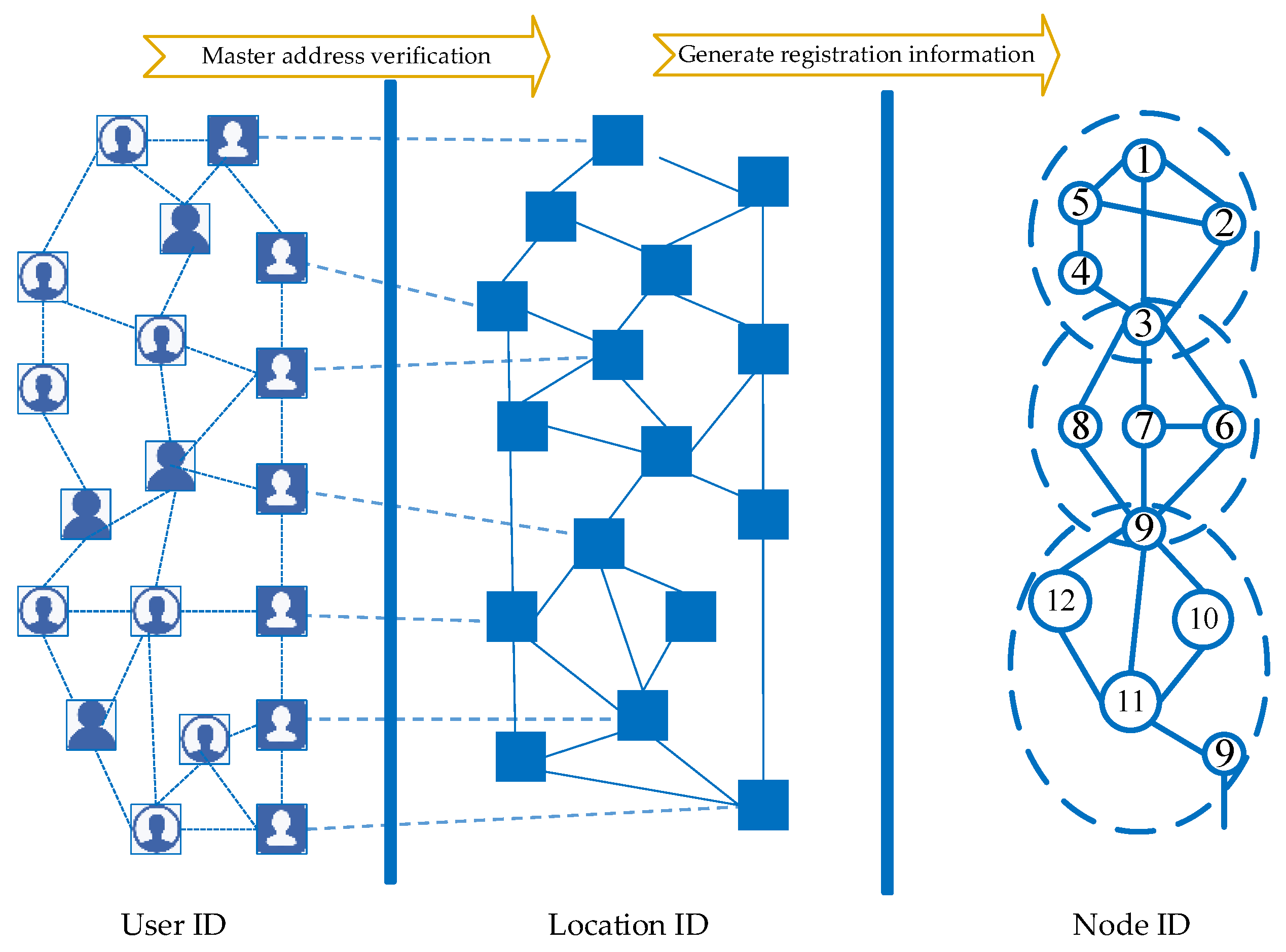
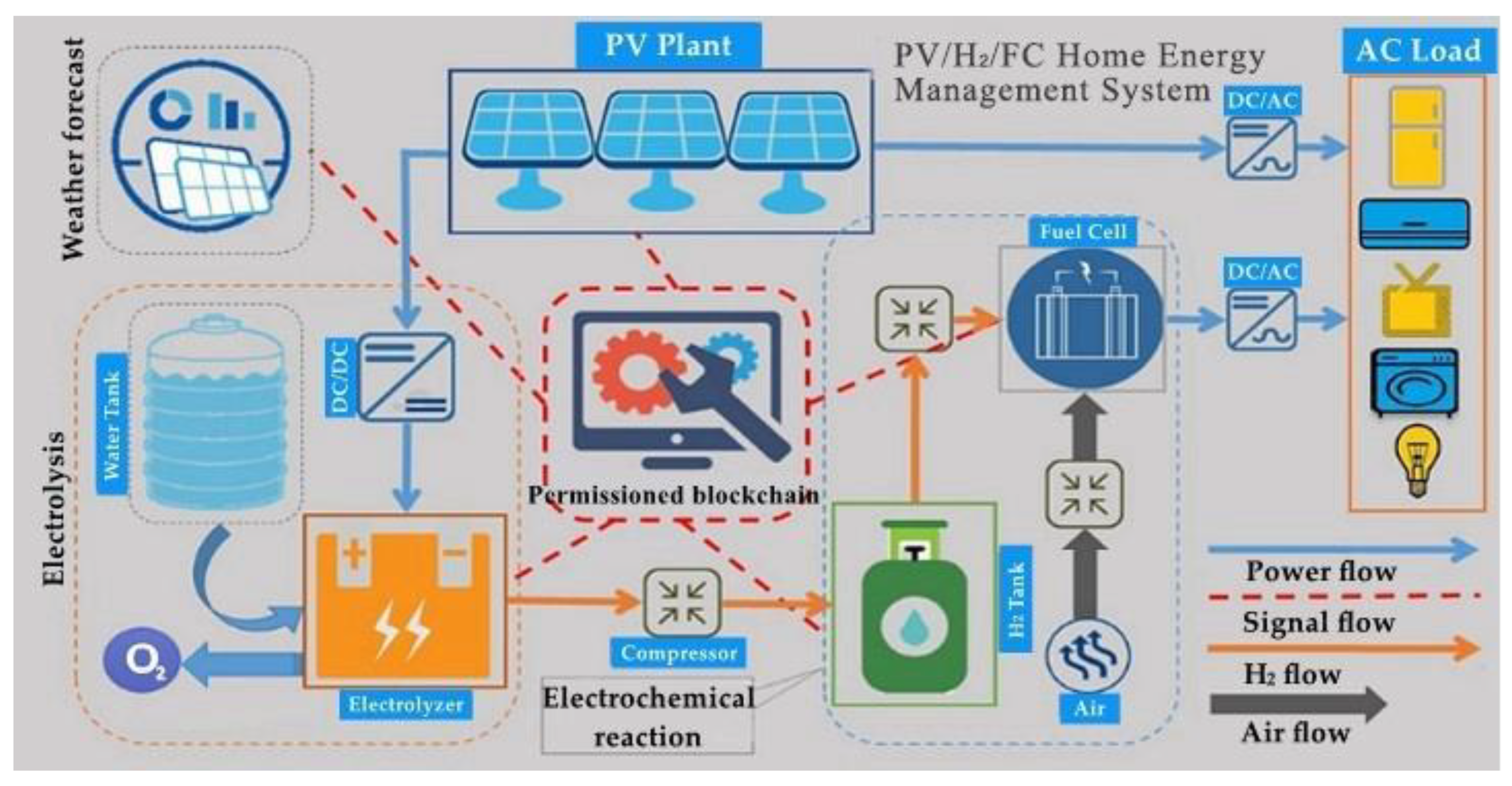
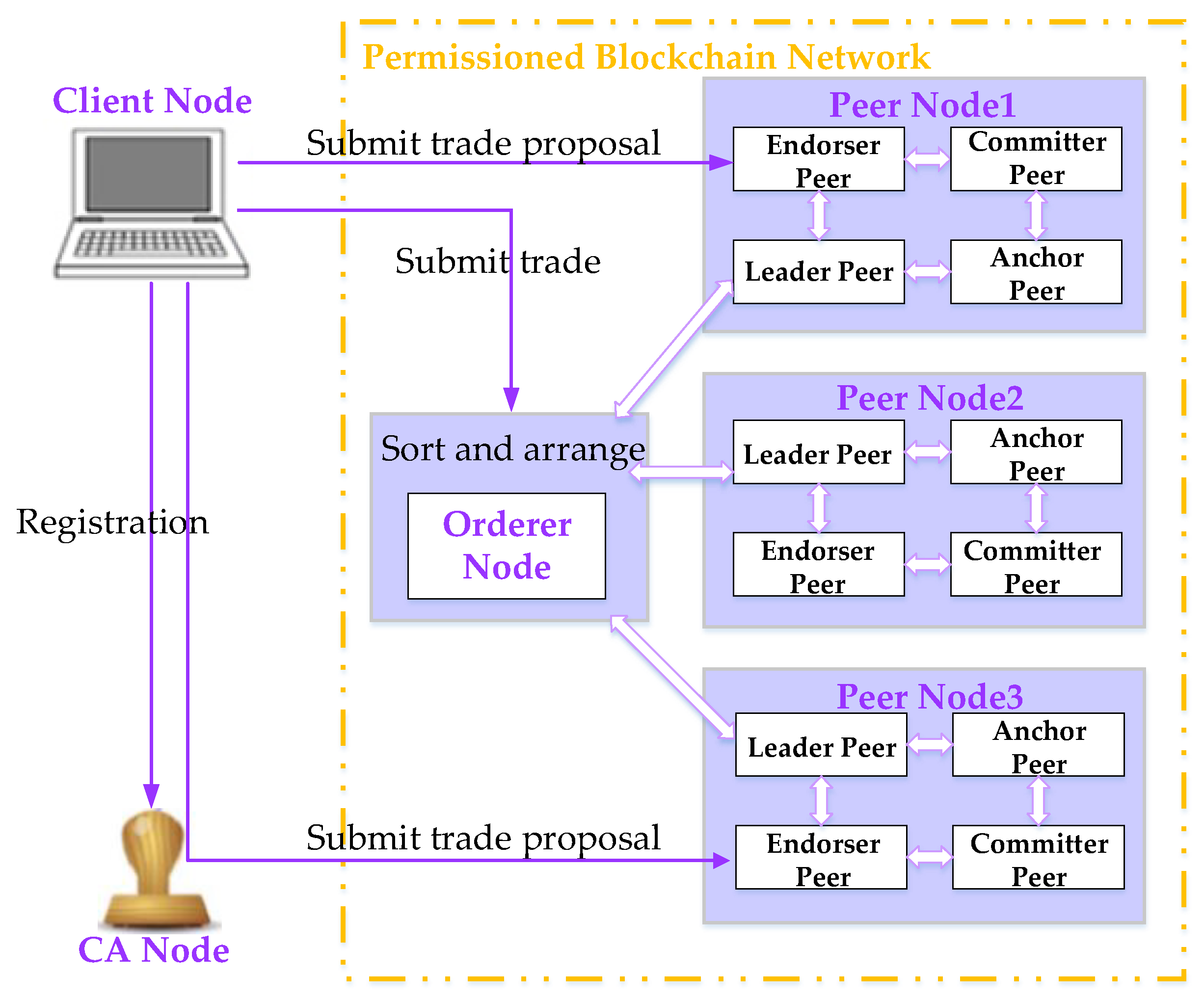
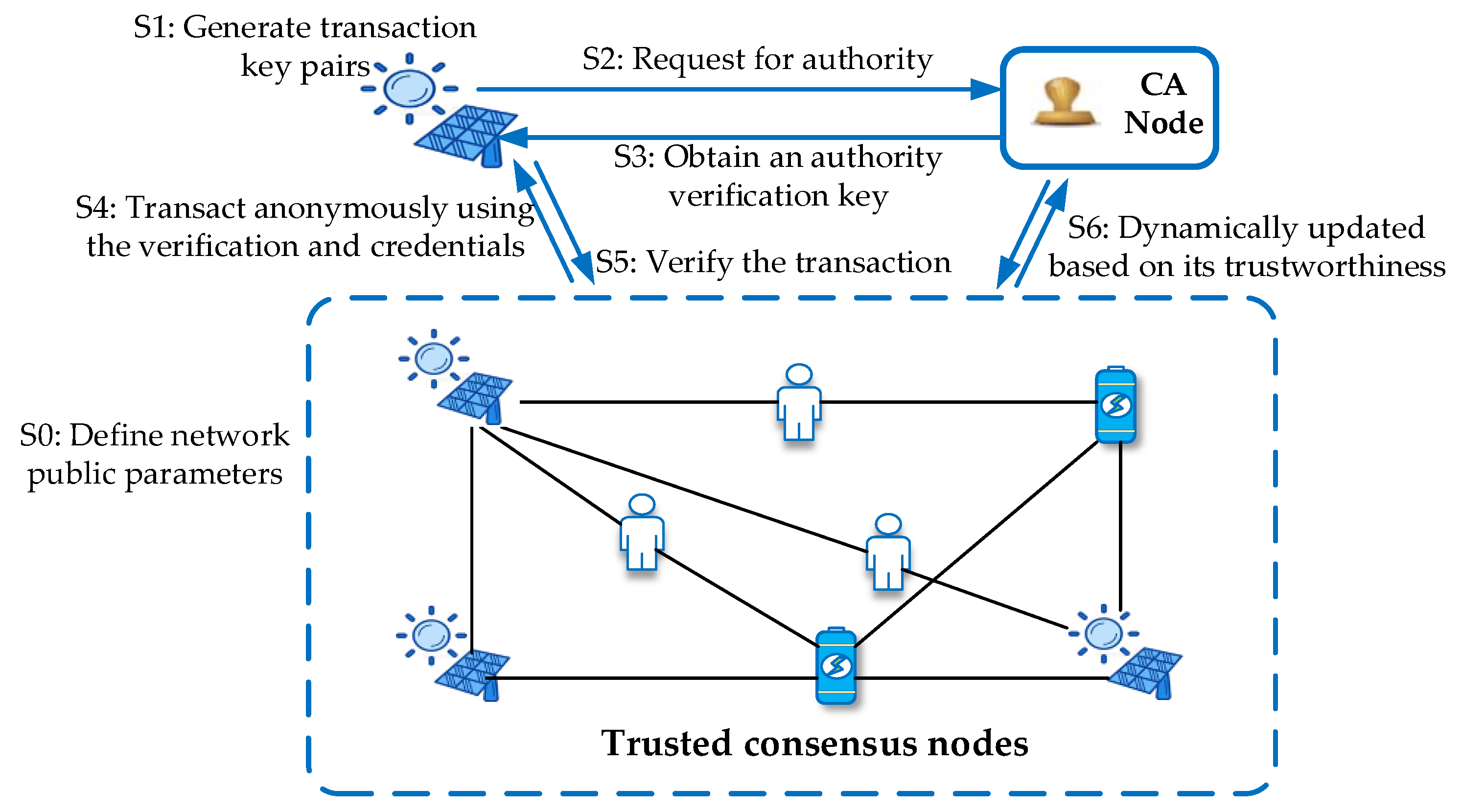

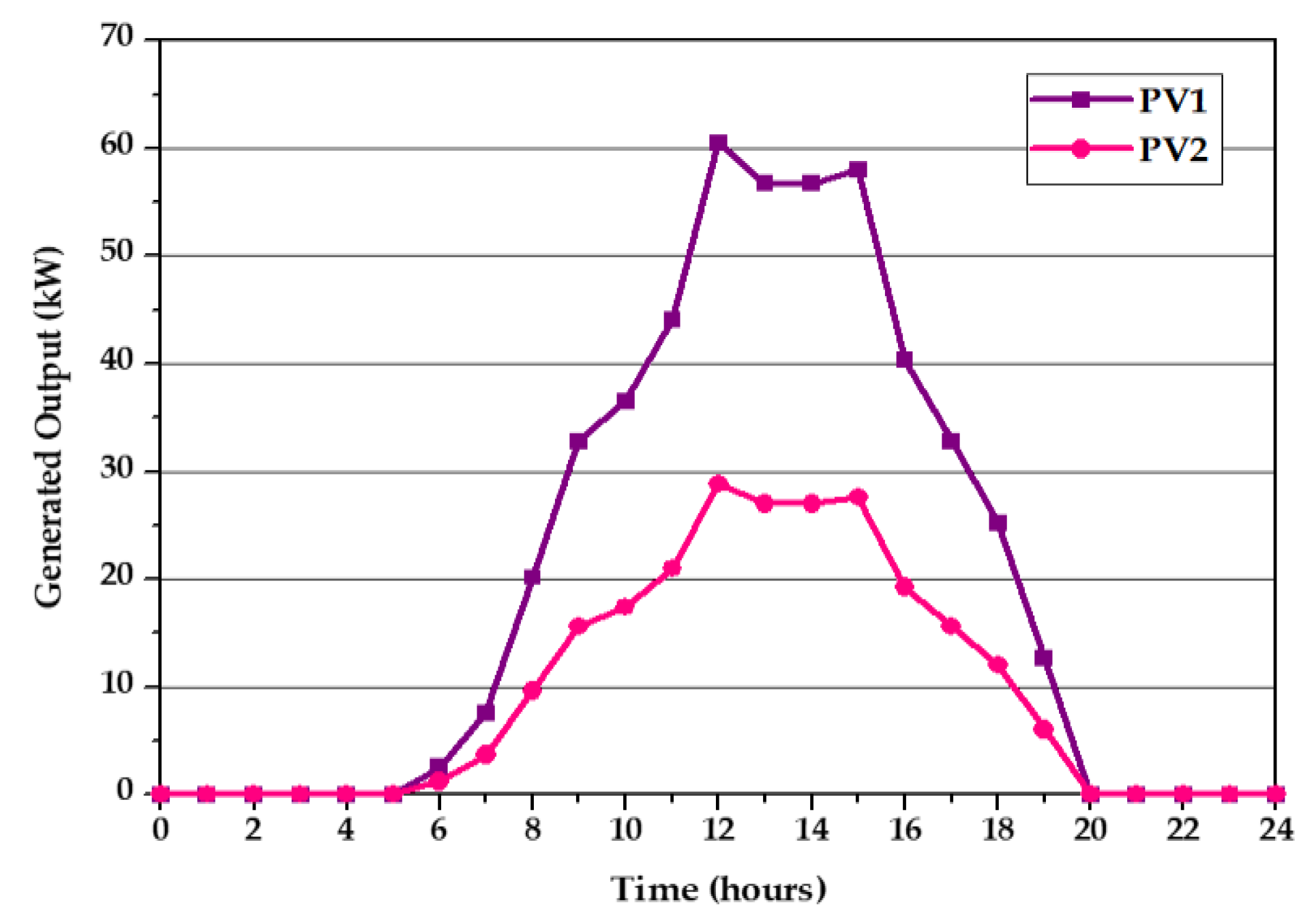
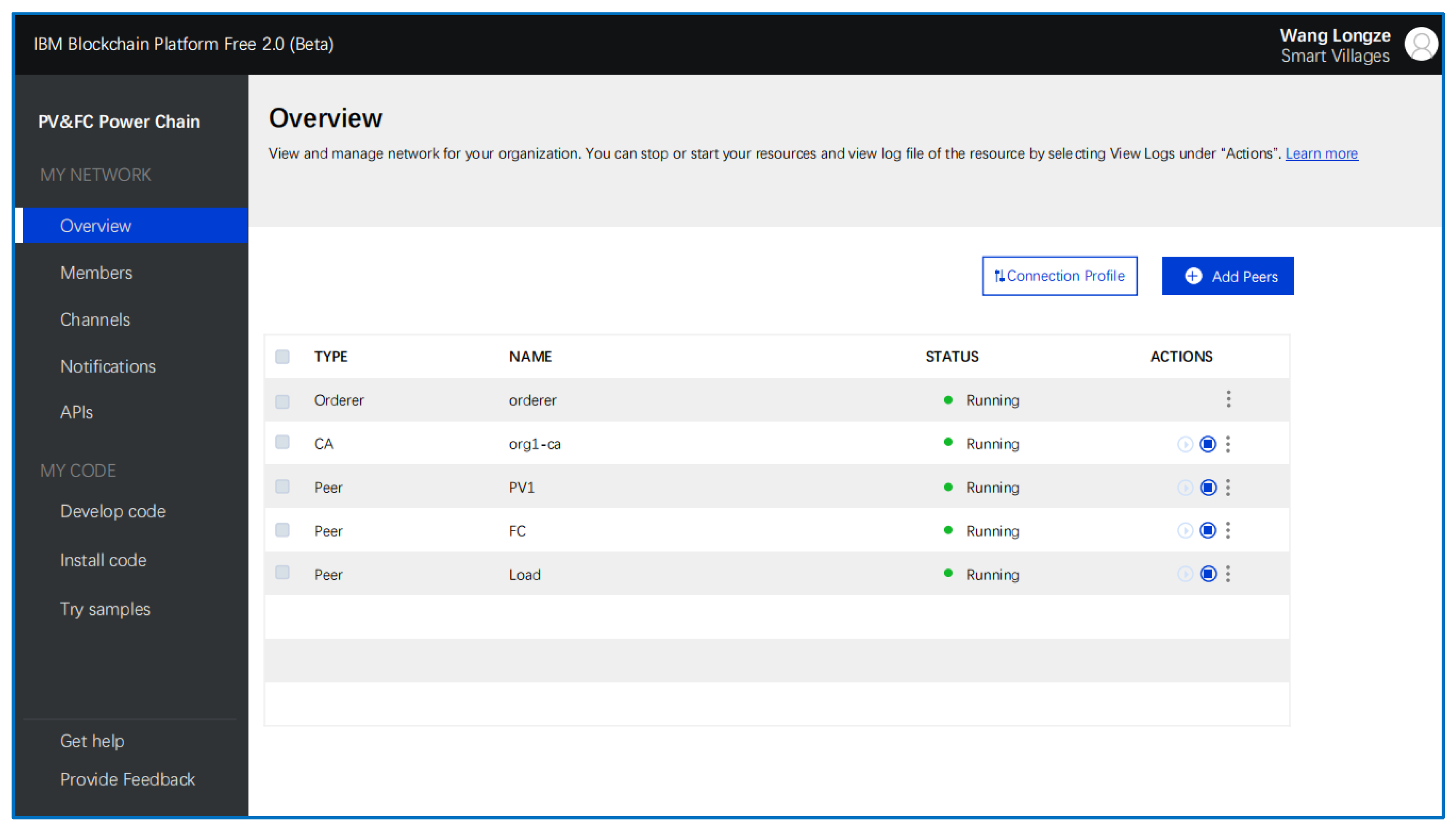
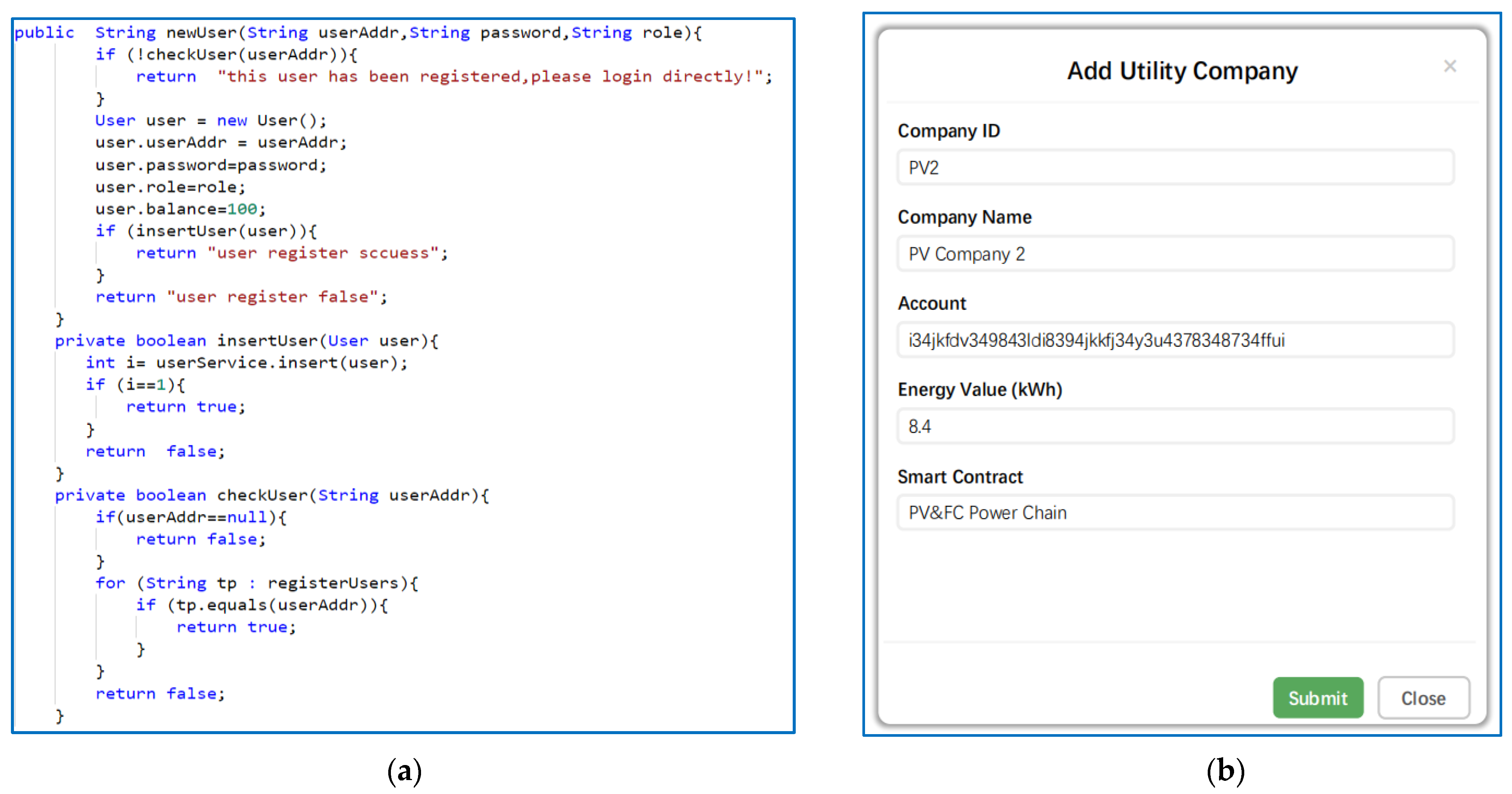
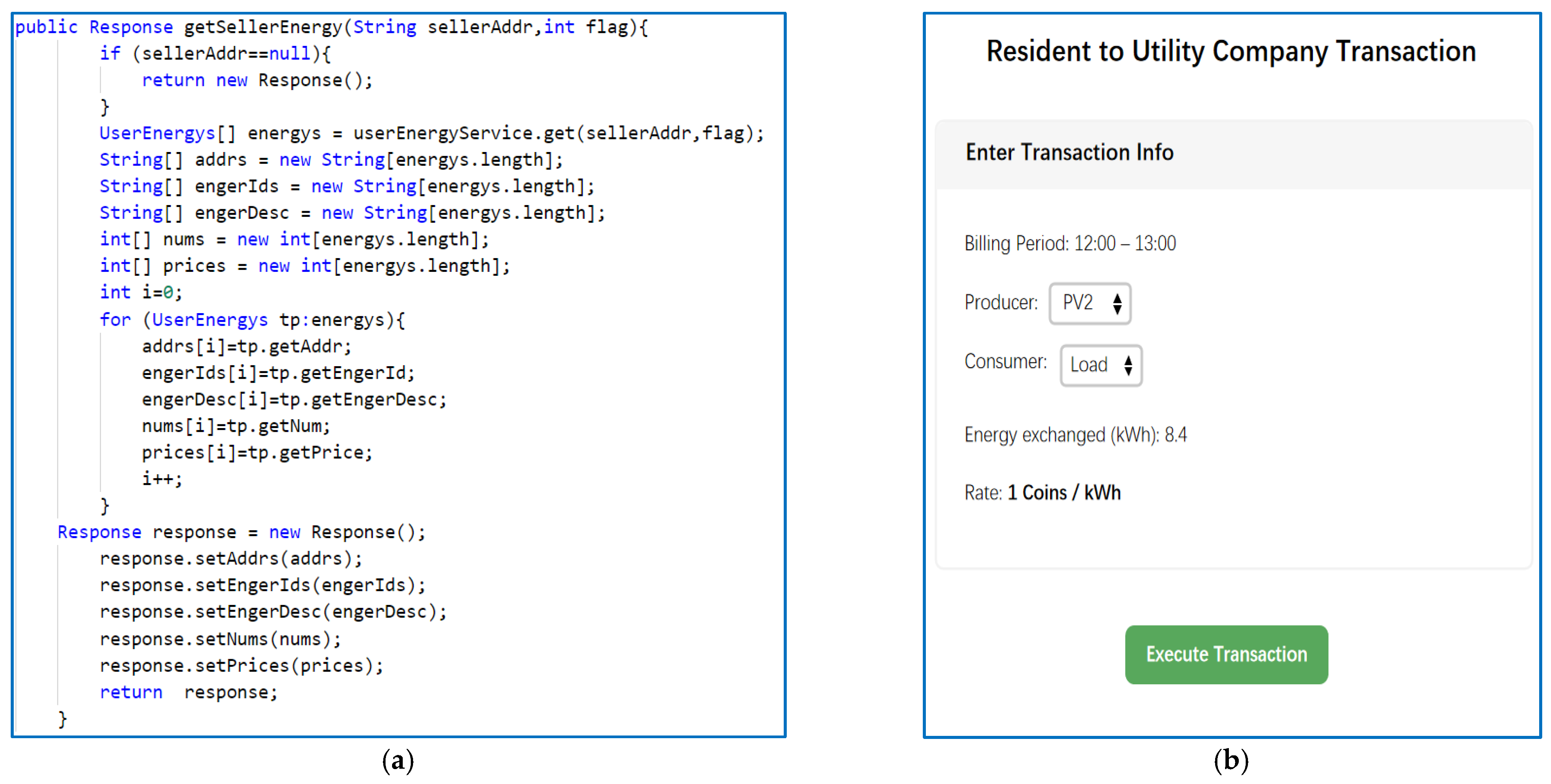
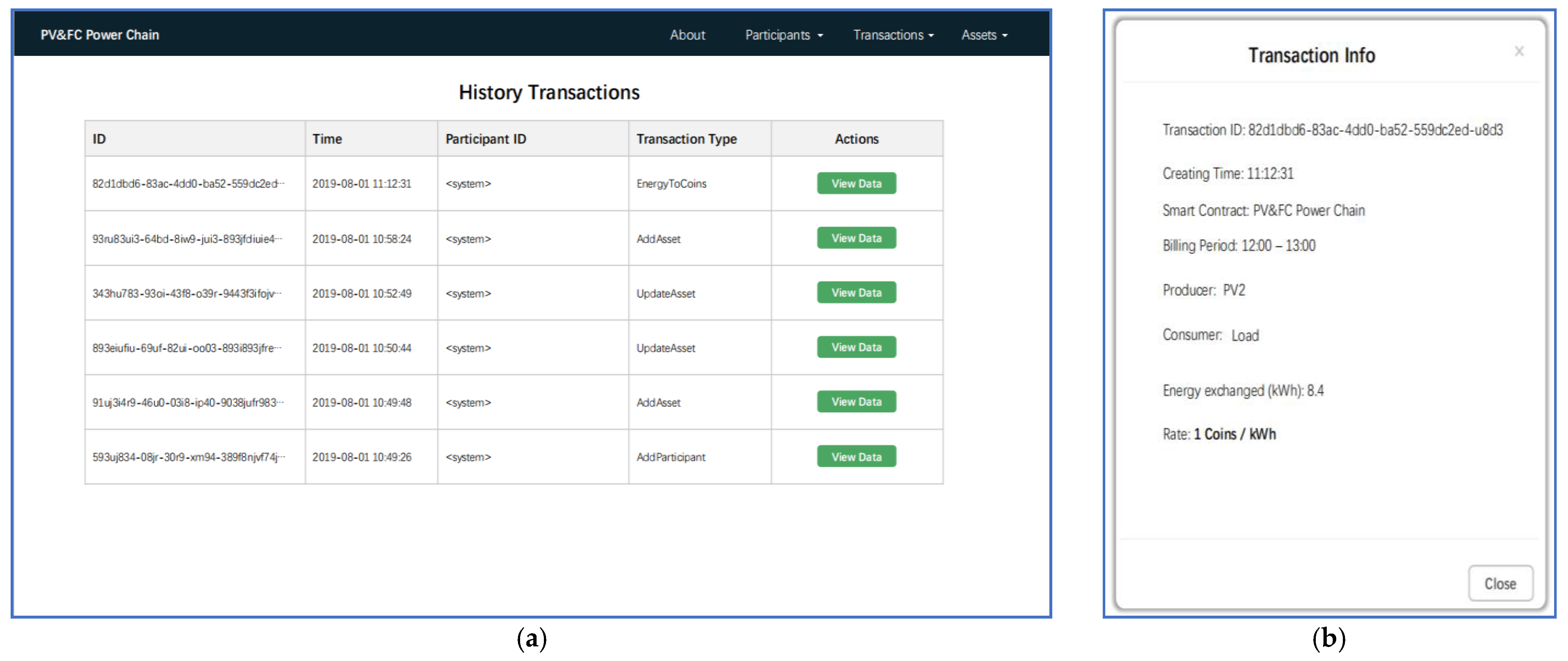
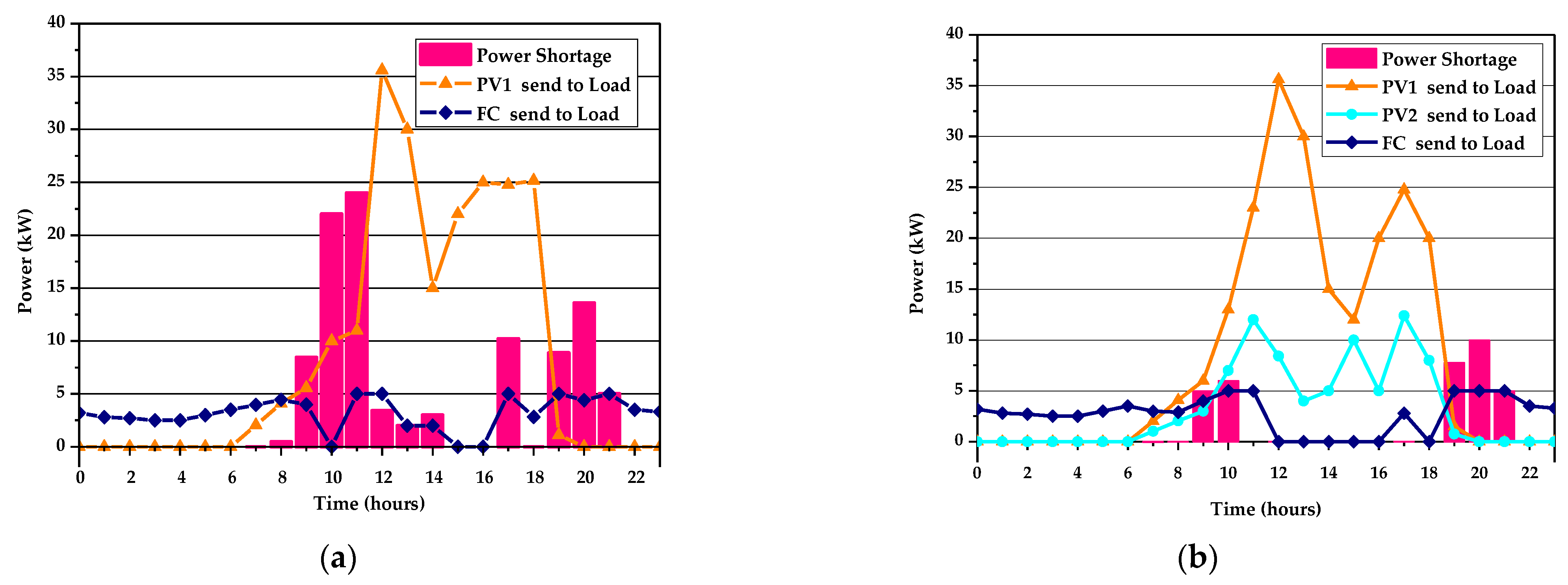
| Technical Index | Public Blockchain [27,28] | Consortium Blockchain [29,30] | Private Blockchain [31] |
|---|---|---|---|
| Degree of centralization | Decentralized | Weak centralized | Centralization |
| Needs motivation or not | Need | Selective | Not |
| Technical features | (1) Protect users from developers (2) All data are exposed (3) Low operating speed | (1) Low operating and maintenance costs (2) Fast operating speed (3) Flexible and expandable | (1) Fast operating speed (2) Privacy is only visible to individual (3) Inextensibility |
| Representation | Bitcoin, Ethereum | RIPPLE, LIP-Chain | Some central systems |
| Trading Manner | Before PV2 Addition | After PV2 Addition | ||
|---|---|---|---|---|
| Electricity Quantity (kWh) | Electricity Charge (USD) | Electricity Quantity (kWh) | Electricity Charge (USD) | |
| Pay to PV1 | 211.37 | 31.71 | 207.01 | 31.05 |
| Pay to PV2 | 0.00 | 0.00 | 78.60 | 11.79 |
| Pay to FC | 75.64 | 13.62 | 64.70 | 11.65 |
| Total | 287.01 | 45.32 | 350.31 | 54.49 |
| Method | Electric Power Operation | Trade Settlement | Staff Required for Running Period (Number) | Annual Staff Cost (USD) | ||
|---|---|---|---|---|---|---|
| Station (Number) | Population (Number) | Station (Number) | Population (Number) | |||
| Traditional Method | 1 | 3 | 0 | 0 | 3 | 45,000 |
| PV&FC Power Chain | 0 | 0 | 1 | 1 | 1 | 15,000 |
Publisher’s Note: MDPI stays neutral with regard to jurisdictional claims in published maps and institutional affiliations. |
© 2021 by the authors. Licensee MDPI, Basel, Switzerland. This article is an open access article distributed under the terms and conditions of the Creative Commons Attribution (CC BY) license (http://creativecommons.org/licenses/by/4.0/).
Share and Cite
Wang, L.; Jiao, S.; Xie, Y.; Mubaarak, S.; Zhang, D.; Liu, J.; Jiang, S.; Zhang, Y.; Li, M. A Permissioned Blockchain-Based Energy Management System for Renewable Energy Microgrids. Sustainability 2021, 13, 1317. https://doi.org/10.3390/su13031317
Wang L, Jiao S, Xie Y, Mubaarak S, Zhang D, Liu J, Jiang S, Zhang Y, Li M. A Permissioned Blockchain-Based Energy Management System for Renewable Energy Microgrids. Sustainability. 2021; 13(3):1317. https://doi.org/10.3390/su13031317
Chicago/Turabian StyleWang, Longze, Shucen Jiao, Yu Xie, Saif Mubaarak, Delong Zhang, Jinxin Liu, Siyu Jiang, Yan Zhang, and Meicheng Li. 2021. "A Permissioned Blockchain-Based Energy Management System for Renewable Energy Microgrids" Sustainability 13, no. 3: 1317. https://doi.org/10.3390/su13031317
APA StyleWang, L., Jiao, S., Xie, Y., Mubaarak, S., Zhang, D., Liu, J., Jiang, S., Zhang, Y., & Li, M. (2021). A Permissioned Blockchain-Based Energy Management System for Renewable Energy Microgrids. Sustainability, 13(3), 1317. https://doi.org/10.3390/su13031317






